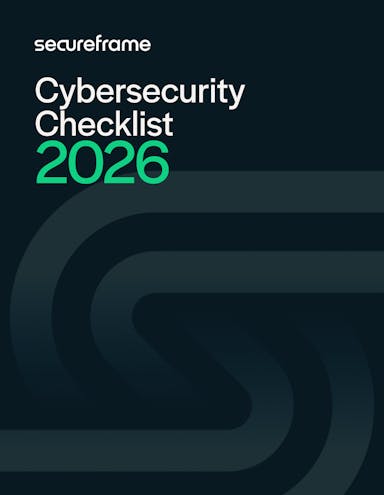
2025’s Biggest Cybersecurity Threats: Analyzing Recent Attacks, Emerging Threats + How to Defend Against Them
Anna Fitzgerald
Senior Content Marketing Manager
Ransomware attacks targeting industrial operators surged by 46% in the first quarter of 2025. US government agencies warn that cyber threats on critical infrastructure are likely heightened. Recent attacks on two major UK businesses resulted in 6.5 million people getting their data stolen and one business going under, putting 700 people out of work.
These are just a few examples of how cybersecurity threats are evolving at an unprecedented pace, becoming more frequent, more sophisticated, and more damaging.
With high-profile breaches making headlines almost weekly, understanding what you’re up against—and how to defend against it—is critical.
This guide breaks down the most common cybersecurity threats today, emerging trends to watch in 2025, and how your organization can build a proactive, risk-informed defense.
What are cybersecurity threats?
Cybersecurity threats are any circumstances or events that have the potential to adversely impact organizational operations, assets, or individuals due to the security of an information system being compromised. A system can be compromised in a number of ways, including unauthorized access, destruction, disclosure, modification of information, and/or denial of service.
Most people think of cybersecurity threats as malicious attempts to access, damage, steal, or disrupt an organization’s data, systems, or infrastructure—which is often the case. These threats come from external attackers (like nation-states or cybercriminals) or insiders (like disgruntled employees or contractors) that are intentionally trying to do harm.
Threats can also come from insiders and third-parties, like vendors and suppliers, that unwittingly do harm. For example, the devastating ransomware attack on KNP Logistics was most likely caused by an employee using a compromised password.
In addition to adversarial and accidental, threat sources can be structural (e.g., system failures), or environmental (e.g., natural disasters), according to NIST SP 800-30 Rev. 1, Guide for Conducting Risk Assessments.

Cybersecurity threats take many forms, including not just ransomware but also:
- Malware
- Phishing and social engineering
- Distributed denial-of-service (DDoS) attacks
- Zero-day vulnerabilities
- Data breaches caused by misconfigured systems or poor access controls
The common thread through all types of cybersecurity threats is that they target the confidentiality, integrity, or availability of your information or information systems.
The impact of these threats—if they result in the loss of confidentiality, integrity, or availability of information—ranges from data theft to reputational damage to legal liability to operational downtime and even business shutdown in some cases.
As the digital transformation accelerates and more organizations have to secure more systems, devices, and individuals, these threats are multiplying at an unprecedented rate and their consequences are increasingly global and disastrous.
Recommended reading

20 Recent Cyber Attacks & What They Tell Us About the Future of Cybersecurity
Top cybersecurity threats to watch in 2025
Understanding the threat landscape is the first step toward effective defense.
Let’s look at the most common cybersecurity threats targeting businesses in 2025 using real-world examples.
1. Ransomware attacks
Ransomware is a type of malware that encrypts a victim’s data and demands payment—typically in cryptocurrency—for the decryption key.
Why this cyber threat matters in 2025
Ransomware remains one of the top cybersecurity threats facing businesses, especially in healthcare, manufacturing, and critical infrastructure. The rise of Ransomware-as-a-Service (RaaS) and faster privilege escalation exploits has made these attacks easier to launch and harder to contain.
Recent real-world example
In May 2025, Interlock ransomware actors targeted Kettering Health, a large U.S. health system. The attack forced the cancellation of surgeries and radiation oncology treatments for nearly a week. Internal systems like messaging and call centers were also shut down, causing widespread patient care disruption.
How to defend against this threat
- Implement multi-factor authentication and strong password policies
- Segment networks and back up critical data offline
- Regularly update and patch software
- Educate employees on phishing and suspicious links
- Use DNS filtering and email/web access firewalls to block delivery paths
Recommended reading

Ransomware Attacks: Definition, 10 Famous Examples & Tips to Prevent Them
2. Social engineering
Social engineering attacks use manipulation rather than malware to compromise systems. Threat actors exploit human trust to gain access to credentials, systems, or sensitive data.
There are many types of social engineering attacks, with the most common being:
- Phishing: Fake emails trick users into clicking malicious links
- Pretexting: Attackers pretend to be someone with authority
- Quid pro quo: Offering fake incentives in exchange for access

Why this cyber threat matters in 2025
Hacker groups like Scattered Spider and ShinyHunters are using social engineering techniques to bypass multi-factor authentication (MFA) and compromise IT help desks at major enterprises, wreaking havoc in several industries, including insurance, retail, aviation and transportation. These attacks are especially damaging because they often require little to no malware, making them harder to detect with traditional security tools.
Recent real-world example
On July 16, 2025, a malicious threat actor used social engineering to access a third-party, cloud-based customer relationship management (CRM) system and obtain personally identifiable data of the majority of Allianz Life’s customers. While the insurance giant did not disclose how many records were compromised, Allianz Life serves approximately 1.4 million customers, making this breach potentially one of the largest in the financial sector this year.
How to defend against this threat
- Conduct frequent security awareness training that includes real-world phishing simulations
- Implement strict MFA policies and consider phishing-resistant methods like FIDO2 or passkeys
- Limit vendor access and perform regular third-party risk assessments
- Use behavioral analytics to flag abnormal user behavior that could indicate social engineering success
- Establish strong escalation protocols for high-risk actions like password resets or financial approvals
Recommended reading

60+ Social Engineering Statistics [Updated 2025]
3. Insider threats
Insider threats involve employees, contractors, vendors, or other individuals within an organization who misuse access to data or systems, whether intentionally or unintentionally.
Intention is what differentiates the two types of insider threats:
- Malicious insiders intentionally steal or sabotage information
- Negligent insiders unintentionally cause harm through poor practices
Why this cyber threat matters in 2025
Insider threats are uniquely difficult to detect. Because these threat actors have legitimate access to sensitive systems, traditional perimeter defenses won’t stop them. As more organizations adopt complex hybrid work environments, the risk of insider compromise grows, whether through deliberate sabotage or careless mistakes.
Recent real-world example
In May 2025, Coinbase disclosed a breach caused by individuals at an overseas support location who improperly accessed customer information. The incident affected nearly 70,000 individuals and highlighted the risks of relying on third-party contractors with privileged access.
How to defend against this threat
- Implement continuous monitoring to detect suspicious behavior across endpoints and applications
- Use user and entity behavior analytics (UEBA) to flag anomalies
- Limit access to sensitive data using least privilege and need-to-know principles
- Log and review privileged user activity regularly
- Train all employees and contractors on security policies and reportable behaviors
4. Data breaches
A data breach occurs when an unauthorized party gains access to sensitive information such as personal data, financial records, or proprietary IP. As seen in this analysis of the biggest data breaches of 2024, data breaches can result from vulnerabilities, phishing, social engineering, or insider threats.
Why this cyber threat matters in 2025
More organizations are at risk for data breaches as both average fix time for security flaws and high-risk security debt increases. According to application security vendor Veracode’s latest State of Software Security report, the average fix time for security flaws has increased from 171 days to 252 days over the past five years and half (50%) of organizations now carry high-risk security debt, defined as accumulated flaws left open for longer than a year.
Additionally, data breaches are likely to have more severe consequences, even if the volume of data stolen is small. According to Lab-1’s Anatomy of a Breach 2025 report, nearly every major breach included financial, HR, and customer data, all of which is highly valuable on the dark web. This means that organizations that experience a data breach have to worry about downstream fraud, lawsuits, and long-term brand damage—not just data loss.
Recent real-world example
After reporting a major data breach in 2024, AT&T experienced another that same year. The second began in April, when a hacker gained access to AT&T’s cloud storage provider, Snowflake, which contained call and text records for almost all 109 million of their U.S. customers.
In June 2025, AT&T agreed to a $177 million settlement for customers adversely affected by at least one of the two data breaches. This case illustrates the legal and reputational consequences of large-scale data breaches.
How to defend against this threat
- Conduct regular vulnerability assessments and penetration tests
- Monitor for misconfigurations and unauthorized access to cloud environments
- Encrypt sensitive data at rest and in transit
- Segment networks to contain breach scope
- Maintain a robust incident response plan to act quickly when breaches occur
Recommended reading

110 of the Latest Data Breach Statistics [Updated 2025]
5. Credential compromise and weak passwords
Credential compromise occurs when attackers gain unauthorized access to systems using stolen, guessed, or reused credentials. It remains one of the simplest and most common attack vectors.
Why this cyber threat matters in 2025
A recent Cybernews study of 19 billion passwords confirmed that insecure password practices persist, with 94% being duplicates or reused. By continuing to rely on weak or repeated passwords, individuals and businesses create a massive opportunity for attackers. A single compromised account can act as a gateway to an entire network—and even without any compromise, hackers can exploit common password patterns, increasing the risk of cyber attacks.
Recent real-world example
KNP Logistics, a 158-year-old U.K. transportation firm, was brought down after attackers exploited a single weak password. The Akira ransomware gang encrypted core systems and demanded a ransom the company couldn’t pay. As a result, KNP ceased operations entirely, leaving hundreds of employees jobless. This incident highlights how even well-established companies can be undone by basic cybersecurity failings.
How to defend against this threat
- Implement a password policy aligned with NIST SP 800-63B, including length over complexity
- Use password managers to eliminate reuse across systems
- Enforce MFA by default for all user accounts, especially privileged users
- Monitor for credential stuffing and brute-force attempts using login telemetry
- Rotate credentials for dormant accounts and deprovision unused accounts promptly
Recommended reading

125+ Password Statistics to Inspire Better Security Practices in 2025
6. Investment fraud
Investment fraud scams target individuals and organizations by promising unrealistic financial returns, often through phishing, fake cryptocurrency platforms, social media outreach, or fraudulent investment apps.
Why this cyber threat matters in 2025
According to the FBI’s 2024 Internet Crime Report, investment fraud investment fraud was the costliest cybercrime in the U.S., with over $6.57 billion in reported losses. In 2025, investment fraud isn’t just affecting consumers—it’s increasingly impacting businesses, especially as attackers impersonate venture capitalists, business partners, or financial advisors.
Recent real-world example
On 25 June 2025, the Spanish Guardia Civil, with the support of Europol and law enforcement from Estonia, France and the United States, dismantled a criminal network involved in cryptocurrency investment fraud. The group laundered €460 million through shell companies and crypto exchanges, deceiving over 5,000 global victims. Their tactics included cloned investment platforms and fraudulent outreach via social media and messaging apps.
How to defend against this threat
- Establish anti-fraud policies aligned with frameworks like SOX or PCI DSS
- Verify financial transactions through out-of-band methods and multi-person approval
- Vet investment partners and platforms before making commitments
- Educate employees on red flags for phishing and fake investment opportunities
7. Business email compromise (BEC)
Like investment fraud, BEC is one of the most prolific online fraud schemes. While traditional phishing attacks cast a wide net, BEC is highly targeted and often difficult to detect, with threat actors impersonating executives, vendors, or partners to trick employees into making fraudulent wire transfers or disclosing sensitive data.
Why this cyber threat matters in 2025
Though the volume of BEC complaints has plateaued, the average cost per incident continues to rise—totaling $2.77 billion in losses according to the FBI’s 2024 Internet Crime Report. As attackers refine techniques like domain spoofing and thread hijacking, BEC remains one of the most lucrative and persistent cyber threats.
Recent real-world example
In early 2025, attackers compromised the Microsoft 365 account of an executive at a U.S. aviation firm. Using a lookalike domain and stolen credentials, they intercepted invoice communications and rerouted payments, resulting in a six-figure loss after a client wired funds to the scammers.
How to defend against this threat
- Enable email security tools with spoof detection and URL filtering
- Require verbal confirmation for all changes to payment details
- Use role-based access controls to restrict who can initiate or approve wire transfers
- Conduct regular BEC simulations during employee security training
8. Distributed Denial of Service (DDoS) Attacks
DDoS attacks are designed to overwhelm a system, network, or application with a flood of traffic, rendering it inaccessible to legitimate users. While not always data-destructive, they can disrupt business operations, damage brand reputation, and even be used as cover for other intrusions.
Why this cyber threat matters in 2025
In 2025, DDoS attacks are becoming more powerful and frequent. Botnets have expanded due to unsecured IoT devices, and attackers are increasingly launching ransom-driven DDoS (RDoS) attacks.
In the first two quarters of 2025, Cloudflare has blocked nearly 28 million DDoS attacks, surpassing the number of attacks it mitigated in all of 2024. The number of hyper-volumetric DDoS attacks is also increasing at an alarming rate, with Cloudflare mitigating over 6,500 attacks in Q2 2025 alone. This is an average of 71 per day.
Recent real-world example
In March 2025, the social platform X (formerly Twitter) experienced severe service outages after being hit with multiple DDoS attacks claimed by the Dark Storm Team. The attacks disrupted millions of users and prompted investigations into backend infrastructure vulnerabilities.
How to defend against this threat
- Use DDoS mitigation services from CDNs or ISPs
- Secure IoT devices and perform regular firmware updates
- Implement rate limiting and web application firewalls (WAFs)
- Use anomaly detection tools to identify and respond to spikes in traffic quickly
Now that we’ve covered some of the most prevalent types of cyber threats, let’s look at some threats that may not be as well-known or paid attention to—but will be soon.
Emerging cybersecurity threats 2025
Cybercrime is evolving. Here are the top emerging cybersecurity threats you’ll need to watch this year and beyond.
1. Organized crime
Organized cybercrime is rapidly scaling due to automation, ransomware-as-a-service, and untraceable cryptocurrency transactions. It now poses one of the greatest security threats to the European Union (and the world).
Why this cyber threat is growing
According to the 2025 EU Serious and Organised Crime Threat Assessment (EU-SOCTA), organized crime is evolving. Criminal groups are increasingly deploying large-scale online fraud schemes and politically-motivated cyberattacks, both of which are happening at an unprecedented scale, variety, sophistication, and reach due to artificial intelligence and other new technologies such as blockchain or quantum computing.
Recent real-world example
The LockBit ransomware group, which operates a ransomware-as-a-service model that enables affiliates to launch attacks with minimal expertise, is responsible for billions of euros in damages. In February 2024, LockBit operations were disrupted by international law enforcement. Yet the group continues to evolve and inspire similar groups like Interlock, which shares similarities in terms of attack structure, tool usage, and emphasis on recovery sabotage.
How to defend against this threat
- Prioritize threat intelligence feeds to monitor known criminal groups
- Adopt zero trust architecture and strict access controls
- Use compliance frameworks like ISO 27001 or CMMC to harden systems
2. AI cybersecurity threats
AI is transforming cybersecurity—but not just for defenders. Attackers are using generative AI to:
- Automate phishing at scale
- Craft realistic social engineering messages
- Analyze stolen data for high-value targets
- Launch polymorphic malware that adapts to defenses

Why this cyber threat is growing
Because AI accelerates phishing, deepfakes, malware development, and more, attacks are getting faster, more sophisticated, and harder to detect. This means attacks are faster, more sophisticated, and harder to detect. This is particularly true for investment fraud, which is one of the most common and growing types of online fraud powered by AI.
Recent real-world example
The JuicyFields investment fraud scheme defrauded over 500,000 investors across Europe through a fake cannabis crowdsourcing operation. The criminals used AI-generated content, fake offices, and digital personas to establish trust. The scheme impacted a high number of individuals throughout the EU, with a total reported losses over €645 million, although they may be significantly higher.
How to defend against this threat
- Leverage AI-driven anomaly detection and behavior analytics
- Train staff to recognize AI-generated threats and deepfakes
- Continuously update detection systems against polymorphic malware
Recommended reading

How Artificial Intelligence Will Affect Cybersecurity in 2024 & Beyond
3. Advanced Persistent Threats (APTs)
APTs are long-term, targeted cyberattacks often orchestrated by nation-states or organized criminal groups that are highly skilled. Unlike smash-and-grab ransomware attacks, APTs are stealthy and strategic, aiming to maintain persistent access to networks over months or even years for the purpose of espionage, data theft, or sabotage.
Industries at high risk for APTs include:
- Government and defense (often linked to cyber warfare)
- Critical infrastructure (e.g., energy, water, healthcare)
- Financial institutions
- High-tech and IP-heavy sectors
Why this cyber threat is growing
In 2025, APTs are growing in both scale and impact, with Intel 471’s latest intelligence update for July revealing a surge in sophisticated cyber campaigns carried out by APT groups across the globe in June. Attackers are blending into legitimate network traffic, using fileless malware, and exploiting trusted third-party vendors to bypass traditional defenses. They often begin with social engineering or spear phishing to gain an initial foothold, then escalate privileges and move laterally across systems.
These threats are expected to keep pace with the surge in cyber warfare and rising geopolitical instability.
Recent real-world example
In mid-2025, groups APT33 and APT39 ramped up attacks on defense contractors, energy producers, and critical infrastructure such as telecommunications and travel across North America, Europe, and the Middle East. These groups use a combination of wipers, credential harvesting, and ransomware to maintain persistent access.
How to defend against this threat
- Implement frameworks specifically designed to protecting highly sensitive information against APTS, like NIST 800-172 and CMMC Level 3
- Leverage advanced threat hunting and EDR tools
- Use network segmentation and limit lateral movement
- Stay connected to threat intelligence sources and patch vulnerabilities fast
4. Zero-Day Exploits
Zero-day exploits target a vulnerability that is unknown to the software vendor and has no patch available. These exploits are among the most dangerous types of cybersecurity threats because they allow attackers to strike before defenders even know a vulnerability exists.
Why this cyber threat is growing
In 2025, threat actors are increasingly using zero-days to target critical applications, firmware, and cloud environments. More attackers are buying and selling zero-days on the dark web and combining them with phishing and lateral movement tactics.
Recent real-world example
In July 2025, a critical vulnerability in Microsoft SharePoint Server (CVE-2025-53770) was actively exploited in the wild before Microsoft issued a patch and weaponized as part of an "active, large-scale" exploitation campaign.
How to defend against this threat
- Develop and maintain a robust vulnerability management program
- Deploy virtual patching when possible
- Subscribe to vendor alerts and apply emergency updates immediately
- Following the principle of least privilege to limit attacker movement
5. Software supply chain attacks
Software supply chain attacks are a subset of supply chain attacks in which attackers target vulnerabilities in third-party software, open-source components, and development pipelines to infiltrate larger organizations.
Why this cyber threat is growing
In 2025, Cyble reported escalating cyber threats in software supply chains, with 25 attacks per month affecting 22 of 24 critical sectors. Open-source vulnerabilities, complex vendor ecosystems, and rapidly evolving tools and attack methods have made these attacks easier, more damaging, and harder to detect and analyze.
Recent real-world example
In May 2025, Everest Group launched nine new cyber attacks against large organizations in the Middle East, Africa, Europe, and North America, and began extorting victims over records stolen from their human resources departments. Investigations linked the breaches to a compromised SAP SuccessFactors service provider, which affected healthcare organizations to construction and facilities management companies to Coca-Cola.
How to defend against this threat
- Follow NIST guidelines for software supply chain security
- Perform third-party risk assessments and maintain vendor inventories
- Use network microsegmentation to isolate supplier access
- Require compliance from vendors with standards like SOC 2, ISO 27001, or CMMC
Cybersecurity Checklist for 2026
As cyber threats continue to evolve in scope, scale, and sophistication, organizations must take a proactive, structured approach to defense. A strong cybersecurity strategy isn’t just about patching known vulnerabilities—it’s about anticipating new attack vectors, protecting data at every level, and staying one step ahead of threat actors.
To help you do just that, we’ve created a comprehensive cybersecurity checklist for 2026 and beyond.
This checklist includes actionable best practices across all key security domains:
- General IT and security hygiene
- Device and endpoint security
- Software and application security
- Data storage and processing security
- End-user security and access management
- Physical and environmental controls
- Automated monitoring and security operations
Whether you’re just starting to build your cybersecurity program or looking to strengthen and scale existing controls, this checklist can help you assess your current security posture, identify areas of improvement, and fortify against today’s most common and costly cyber threats.

Cybersecurity Checklist for 2026
Use this downloadable security checklist to assess your current security practices, close any gaps, and fortify against future threats.
Now that we have a better understanding of the most prevalent and emerging cyber threats, let’s zoom in on how these threats are impacting one specific critical infrastructure sector: healthcare.
Cybersecurity threats in healthcare
The healthcare sector consistently experiences some of the highest volumes of attacks across all industries, often with the heftiest price tags and most damaging consequences.
In fact, 92% of healthcare organizations reported experiencing a cyberattack in 2024, with almost 70% reporting disruption to patient care due to cyber attacks.
While the global average cost of a damaging cyber attack was reported to be $4.4 million that same year, the cost was 25% higher in the healthcare sector at $5.3 million.
Let’s take a closer look at the types of threats that are leading to these costly attacks in the health care sector specifically.

1. Phishing
A recent Netrix survey of healthcare IT and security professionals revealed 84% detected a cyberattack or intrusion in the past 12 months, with phishing as the most common type of attacks for organizations with on-premises infrastructure and second most common for organizations with cloud-based infrastructure.
Why this cyber threat is prevalent in healthcare
Healthcare workers can be particularly vulnerable to phishing attacks for two reasons, according to Dirk Schrader, VP of Security Research and Field CISO EMEA at Netwrix.
First, because they regularly communicate with people they don’t know, from patients to laboratory assistants to auditors, and more, the burden of properly vetting every message is much higher than in other industries.
Additionally, they are less likely than workers in other sectors to receive regular security awareness training since patient care takes precedence.
Recent real-world example
In April 2025, PIH Health, Inc. (PIH), a California health care network, reached a $600K settlement after a phishing attack compromised forty-five of its employees’ email accounts and exposed the unsecured electronic PHI of nearly 200,000 individuals.
How health care organizations can defend against this threat
- Provide tailored HIPAA training to all staff
- Conduct regular phishing simulations and response drills
- Review and update risk management plans to reflect email threats
2. Ransomware
Ransomware attacks have resulted in the exposure or theft of the healthcare data of at least 285 million individuals over the past 15 years. This number is expected to rise as this type of attacks on health care organizations has been trending upward since the third quarter of 2024, according to Health-ISAC Heartbeat.
Why this cyber threat is prevalent in healthcare
Healthcare organizations are a prime target for ransomware attacks. Because an attack can force them to delay medical procedures, divert patients to other facilities, reschedule
medical appointments, and otherwise disrupt patient care, healthcare organizations are more likely to pay ransoms to restore operations. According to a report by Claroty, more than three-quarters of healthcare organizations paid more than $500,000 in ransom in 2024.
Recent real-world example
In June 2024, a ransomware attack on Synnovis, a UK-based pathology lab serving National Health Service Trusts, caused massive disruption to testing and blood services for several months, resulting in thousands of cancelled appointments and prolonged blood shortages. The attack cost an estimated £32.7 million ($38.18 million) last year.
How health care organizations can defend against this threat
- Maintain secure, offline, and immutable backups of critical data
- Patch software and update systems frequently
- Enforce least-privilege access and strong password hygiene
3. Supply chain attacks
Supply chain attacks are also becoming increasingly prominent in the healthcare sector, with a recent report by Darktrace finding that the exploitation of vulnerabilities in the health care supply china was one of the most common initial access vectors in 2024.
Why this cyber threat is prevalent in healthcare
Healthcare relies on a broad ecosystem of EHR vendors, billing firms, diagnostic labs, medical device manufacturers, and cloud service providers. These third parties often store or have direct access to PHI and network systems, making them prime targets for attackers looking to exploit the weakest link in the healthcare supply chain.
As healthcare continues to undergo a digital transformation and interconnect with more systems and devices, the sector is increasingly vulnerable across the supply chain.
Recent real-world example
A data breach at healthcare services firm Episource exposed sensitive information of 5.4 million people, including prescriptions, diagnoses, and Social Security numbers. As a third-party contractor that provides coding, billing, and risk adjustment services to doctors, hospitals, and insurance providers, Episource had records of millions of patients and was an ideal target for hackers.
How health care organizations can defend against this threat
- Maintain an up-to-date inventory of third-party systems and assets
- Assess vendor security posture during onboarding and annually
- Require signed BAAs (Business Associate Agreements) and cybersecurity attestations
Recommended reading

Risk Management in Healthcare: How to Build Organizational Resilience
Cybersecurity threats and cyber warfare
Cyber warfare has emerged as one of the most serious cybersecurity threats facing governments and private sector organizations alike. Nation-state actors are increasingly leveraging cyberattacks as a means of espionage, disruption, and strategic advantage.
These campaigns often target critical infrastructure, financial systems, healthcare organizations, and defense contractors with the goal of weakening adversaries without firing a single shot.
These attacks may be aimed at:
- Disrupting communications
- Stealing state secrets
- Undermining public trust
- Triggering geopolitical instability
Recent cyber warfare incidents have done exactly that, including:
- Wiper malware deployed in active military conflicts
- State-sponsored ransomware attacks against US and other government agencies
- Coordinated disinformation and phishing campaigns
- Targeted attacks on satellite communications and supply chains
This rise in nation-state activity has driven renewed urgency across sectors, but especially in the Defense Industrial Base (DIB), which is responsible for producing and securing sensitive military systems and information.
The U.S. Department of Defense works with over 300,000 contractors, subcontractors, and service providers—collectively known as the DIB. These companies often handle sensitive information, like technical drawings, specifications, and mission-critical data called Controlled Unclassified Information (CUI). For years, this information was governed by DFARS 7012, which required companies to follow NIST SP 800-171 security controls. But since there was no formal system to verify compliance, gaps remained and adversaries exploited them.
That’s why the DoD launched the Cybersecurity Maturity Model Certification (CMMC). Originally introduced in 2020 and updated in 2021 as CMMC 2.0, this framework introduces mandatory cybersecurity requirements and third-party assessments for organizations handling CUI. The goal is to ensure that all members of the DIB—from the largest prime contractors to the smallest subcontractors and service providers—have the capabilities to protect national security information.
CMMC 2.0 is just one example of how governments are evolving their cybersecurity strategies to address the realities of modern cyber warfare. For organizations supporting federal agencies or critical infrastructure, building resilience isn’t optional. It’s a national and global security imperative.
Recommended reading

Cybersecurity Explained: What It Is & 13 Reasons Cybersecurity is Important
How to defend against today's cybersecurity threats
Understanding the top cybersecurity threats is only the first step. Here’s some tips for building a strong defense against them.
1. Conduct regular cybersecurity risk assessments
Assessing cybersecurity risk is critical to prioritizing threats and allocating security resources effectively. A cybersecurity risk assessment can help you:
- Identify your organization’s most valuable data and systems
- Identify and fill gaps in your security posture
- Develop more effective cyber incident response plans
- Meet compliance requirements for a variety of frameworks, such as SOC 2, ISO 27001, NIST 800-53, CMMC, HIPAA, and GDPR

2. Train employees on security and privacy
Since human error is the leading cause of data breaches, training your team is one of the most impactful defenses against today’s cyber threats. Effective training programs may cover:
- Security awareness
- Security and privacy best practices
- Phishing simulations
- Insider threats
- Secure coding
3. Enforce strong access controls
Unauthorized access is at the root of many costly cybersecurity attacks. Enforcing robust access controls—particularly for sensitive systems like cloud platforms, HR tools, and finance systems—is essential to reduce your organization’s attack surface.
Examples of strong access controls include:
- Implementing role-based access control (RBAC) so employees only access the data and systems necessary for their role.
- Requiring multi-factor authentication (MFA) for all remote access and administrative accounts.
- Logging and monitoring access attempts, especially to privileged systems or sensitive data.
- Regularly reviewing user access permissions to enforce the principle of least privilege.
After implementing all applicable types of access controls, formalizing them in a well-documented access control policy can improve consistency, reinforce security best practices, and ensure compliance.
4. Put secure data handling policies and procedures in place
Data is the lifeblood of a business and one of its greatest liabilities if not handled securely. To keep this data safe, your organization must implement data handling policies and procedures across its lifecycle, from creation and transmission to storage and destruction.
Key practices include:
- Use strong encryption for data at rest and in transit.
- Formalize a data classification policy to determine how sensitive each data type is and how it should be handled.
- Implement a data loss prevention strategy that leverages software to identify and remediate data exposure risks
- Create a data retention policy to ensure data is stored, managed, and disposed of effectively.
5. Run cybersecurity tabletop exercises
Having a cyber incident response plan is key to preventing data loss and meeting compliance requirements—but that’s only the first step. Testing that plan with tabletop exercises that simulate attack scenarios can help your team improve this plan and their response.
These exercises can:
- Expose gaps in your incident response plan
- Strengthen communication between departments
- Improve decision-making under pressure
6. Conduct proactive risk management
A strong cybersecurity program must go beyond reactive defense and move toward proactive risk management. That means routinely identifying potential threats, evaluating their likelihood and impact, and implementing a prioritized risk treatment plan.
Here’s how to put it into practice:
- Run periodic risk assessments to identify and evaluate new vulnerabilities and risks across systems, teams, and third parties.
- Monitor threat intelligence feeds and cybersecurity news to stay informed about industry-specific risks.
- Use a centralized risk register to document each identified threat, risk owner, treatment plan, and mitigation status.
- Link risks to controls and policies so your team can close any gaps and demonstrate clear accountability.

7. Manage vendor and third-party risk
Vendors and other third parties often have direct access to your data, systems, or employees, making them prime targets for attackers. As supply chain attacks become more frequent and sophisticated, a comprehensive vendor risk management (VRM) program is essential.
A robust VRM program should:
- Evaluate vendors before onboarding using standardized security questionnaires, risk assessments, or other due diligence processes.
- Track vendor access rights and data flows to understand exactly what systems or data they can reach.
- Classify vendors by risk tier (e.g., critical, high, medium, low) and determine review frequency accordingly.
- Maintain contracts and SLAs that specify security expectations, breach notification requirements, and termination protocols.
- Leverage automation to streamline vendor reviews, risk assessments, access tracking, and monitoring.
8. Monitor your environment continuously
Cyber threats change quickly, so your defenses must be proactive. Continuous monitoring is critical to a proactive defense because it can help:
- Detect and respond to anomalies and potential threats in real time
- Validate the ongoing effectiveness of security controls
- Alert you to misconfigurations and access changes
- Enhance visibility into your IT environment
- Provide essential information to support risk response decisions
9. Implement cybersecurity frameworks
Cybersecurity frameworks can help formalize your approach to protecting data and systems against a broad range of threats. Common cybersecurity frameworks include:
- CIS Critical Security Controls® (CIS Controls®) is a prioritized set of actions developed by the Center for Internet Security, Inc. (CIS®) that organizations can take to defend themselves against common cyber attack vendors.
- NIST CSF 2.0 is a set of standards, guidelines, and best practices developed by the National Institute of Standards and Technology to help organizations better understand and improve their management of cybersecurity risk.
- SOC 2 is a security framework created by the American Institute of Certified Public Accountants (AICPA) that specifies how service organizations should manage and store customer data based on five Trust Services Criteria (security, availability, processing integrity, confidentiality, and privacy).
- ISO/IEC 27001 is a globally recognized information security standard developed by the International Organization for Standardization (ISO) and the International Electrotechnical Commission (IEC) to help organizations protect sensitive information in a systematic way through the adoption of an information security management system (ISMS).
Implementing a framework ensures you’re covering all critical areas—governance, access control, incident response, and more—and makes it easier to demonstrate your commitment to security and privacy to partners and auditors.
Recommended reading

10 Common Cybersecurity Frameworks: Choosing the Right One for Your Clients
10. Use compliance automation to manage and scale security operations
A compliance automation platform like Secureframe not only makes it easier to achieve and maintain compliance with cybersecurity frameworks, but also to strengthen your overall security posture.
Key benefits include:
- Automated gap analysis and remediation so you know what gaps exist in your controls and policies and how to fill them.
- Continuous monitoring of controls as well as cloud infrastructure, endpoints, and vendors for vulnerabilities or misconfigurations.
- Simplified policy management and pre-built templates that drastically reduce time spent drafting, updating, and distributing documentation for employees to review and accept.
- Built-in training to automate the assignment, tracking, and reporting of security awareness and compliance training.
- End-to-end risk management to continuously identify and assess risks, implement mitigation strategies, and re-assess the impact and likelihood of risks periodically.
- Unified dashboards that allow security and compliance teams to track issues, monitor control status, and prepare for audits efficiently.
With automation, your team can focus on proactively addressing risks and vulnerabilities rather than chasing down paperwork or screenshots to check the box on compliance. It also enables faster, more accurate responses to evolving threats and framework changes.
Stay prepared, not just protected with Secureframe
To keep up with cybersecurity threats that are increasing in sophistication and scale, today’s security programs must be proactive, adaptive, and built around continuous improvement.
By understanding the evolving threat landscape and investing in automation, your organization can reduce risk, build trust, and stay one step ahead of the most common and newly emerging threats.
Secureframe simplifies and automates manual tasks related to security, privacy, and compliance so you can stay protected and prepared for threats to come. Secureframe customers can:
- automate risk assessments and cloud remediation using AI
- manage cybersecurity risks, including third-party risk
- consolidate audit and risk data and information
- conduct continuous monitoring to look for gaps in controls to maintain continuous compliance
- train their workforce on the latest security and privacy best practices
- get personalized advice from security and compliance experts based on their company’s unique risks and industry requirements.
To learn all the ways Secureframe can help your organization defend against cyber threats and simplify compliance, request a demo with one of our product experts.
Use trust to accelerate growth
FAQs
What is a cybersecurity threat?
A cybersecurity threat is any event or actor that has the potential to exploit vulnerabilities in your systems, networks, or personnel to compromise the confidentiality, integrity, or availability of data. Threats can be intentional—like hackers or malicious insider attacks—or unintentional, such as human error or system failure.
What are the most common cybersecurity threats for businesses?
Top cybersecurity threats for businesses include ransomware, phishing, social engineering, insider threats, and data breaches.
What common cybersecurity threat involves human interaction skills?
Social engineering relies on manipulating people rather than exploiting technical vulnerabilities to gain unauthorized access to systems or data. It’s one of the most common and dangerous cybersecurity threats today.
What are the two types of insider threats in cybersecurity?
Malicious insiders intentionally cause harm, while negligent insiders inadvertently cause harm through carelessness or lack of training. Both pose dangerous threats and must be mitigated through access controls, employee training, and other measures.
What is threat modeling in cybersecurity?
Threat modeling is the process of identifying potential threats, assessing their impact, and designing mitigation strategies. Popular methodologies include STRIDE, DREAD, and attack tree modeling, which can help organizations:
- Prioritize security controls based on real risk
- Understand attacker motivations and capabilities
- Strengthen defenses where they matter most
- Follow secure-by-design principles and meet requirements for frameworks like ISO/IEC 27001, SOC 2, and NIST 800-53

Anna Fitzgerald
Senior Content Marketing Manager
Anna Fitzgerald is a digital and product marketing professional with nearly a decade of experience delivering high-quality content across highly regulated and technical industries, including healthcare, web development, and cybersecurity compliance. At Secureframe, she specializes in translating complex regulatory frameworks—such as CMMC, FedRAMP, NIST, and SOC 2—into practical resources that help organizations of all sizes and maturity levels meet evolving compliance requirements and improve their overall risk management strategy.